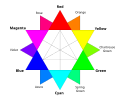
In color science, a color gradient (also known as a color ramp or a color progression) specifies a range of position-dependent colors, usually used to fill a region.
Contents
- Definitions
- Strict definition
- Types
- Dimension
- Shapes
- Color space
- Examples
- HSV rainbow
- Applications
- See also
- References
In assigning colors to a set of values, a gradient is a continuous colormap, a type of color scheme. In computer graphics, the term swatch [1] has come to mean a palette of active colors.
































